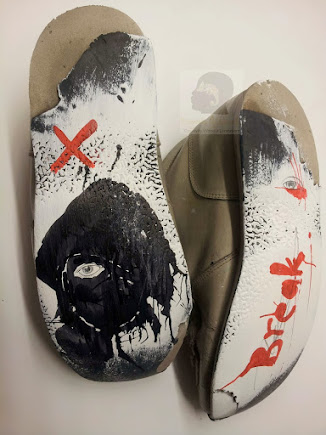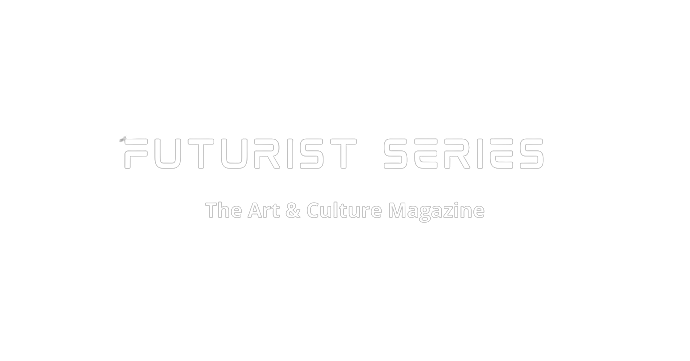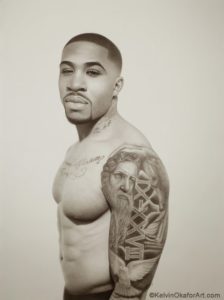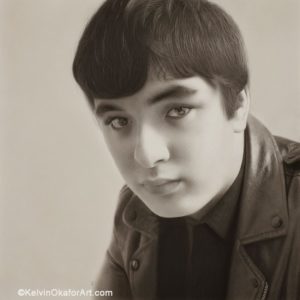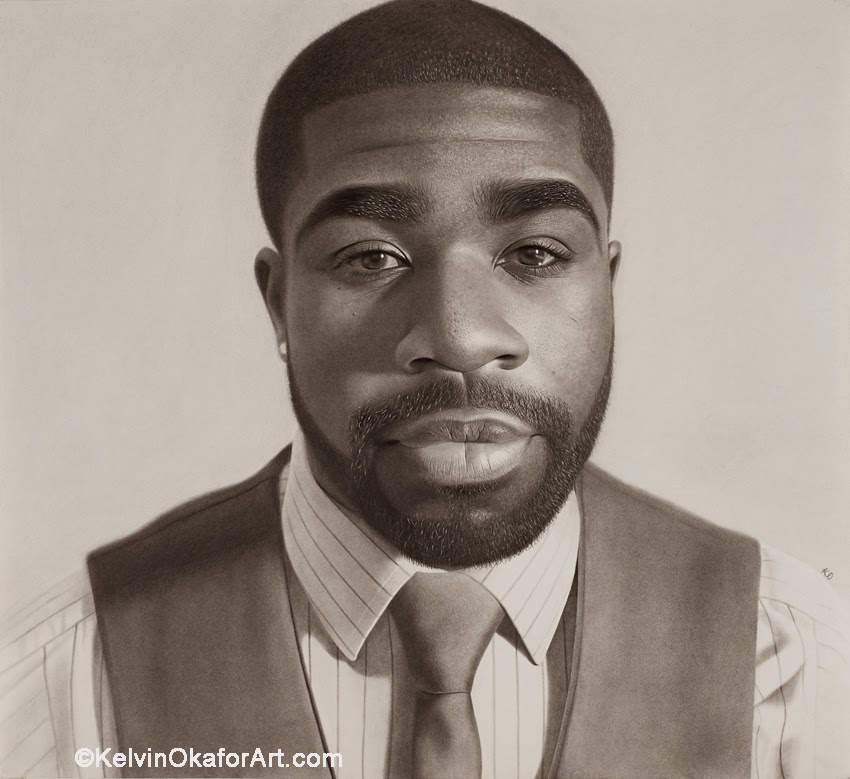
Adelaide Damoah in Conversation with Kelvin Okafor
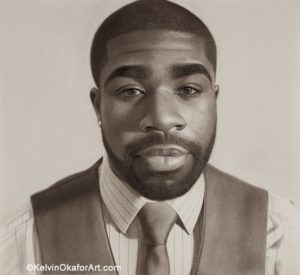 |
| Nwanebuni_(Self Portrait II) |
At only 28 years old, Kelvin Okafor is one of the best draughtsmen of our generation in my opinion. Born in 1985, Okafor’s passion for the pencil started at a very early age. Like many young art world stars, he appears to have come out of nowhere, but Okafor has been quietly perfecting his craft since he was a little boy. When his friends were playing outside, Okafor was inside drawing with his charcoal pencil. His passion for drawing followed him and propelled him to study fine art at Middlesex University from which he graduated in 2009. He has already won awards and had national and international media exposure for his extraordinary talent.
Critic Estelle Lovatt describes the work as “Emotional Realism” in her write up for his exhibition catalogue. She is right. His pencil portraits- some you will recognise and some you will not, leave you feeling… Something… It is like they are alive. They breathe! Okafor’s portraits have more of an impact than any photographic portraits I have ever seen, so labelling his work as photo realism seems somehow wrong.
Okafor’s début exhibition opened at the Albermarle Gallery in Mayfair at the start of May 2014. I was lucky enough to receive an invite to the opening. The work on display was overwhelming and astonishingly beautiful. So perfectly executed that I could only think that he must have been touched by God himself.
Kelvin, a humble, kind and striking young man, was kind enough to take time out of his hectic schedule in the run up to his début show, to discuss his work and dreams with me. It was an inspiring and surprisingly funny conversation.
Adelaide Damoah: I remember you telling me when you first got taken on by the Albermalre Gallery.
Kelvin Okafor: Yea… Still feels like a dream. Every day I am just incredibly appreciative.
AD: I saw on the website that they are giving you a solo show in May?
KO: Absolutely yeah.
AD: So you are working towards that?
KO: Yes. It is so crazy because it’s like, on average it takes 80 to 100 hours to complete a portrait. I am quite surprised that I have been able to keep the work ethic going. With all of the interviews, work shows and shows… It is amazing.
AD: How long did you say it takes you to do one portrait?
KO: On average it is between 80 and 100 hours. Some of my last pieces of work were between 116 and 123 hours.
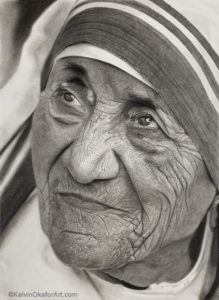 |
| Mother Teresa |
AD: That is a long time wow. To put that into context, how many days is that?
KO: When I have a free day, I do 12 to 14 hours of drawing. I wake up at six, I read for two hours, I work out for two hours and I start at 10 and I finish at two am. It takes like a week and a bit to do a portrait- that is if I have that many days free to draw.
AD: That is serious! Well saying that, it sounds like my typical day, but I don’t get to spend that much time on art. It seems to be the way for many creative types- especially staying up late.
KO: I guess the plus side is that I am doing something I love to do. It does not necessarily feel like work. I don’t even feel like I am on this planet when I draw. I just zone out and hours pass without eating. My friends tell me that I need to relax and take time out, but for me it is not work.
AD: I completely understand where you are coming from. My record for a painting was 18 hours straight. If it wasn’t for people who cared about me reminding me to eat and drink something, I probably would not have because you are just in the zone! You graduated in Fine Art from Middlesex in 2009 right?
KO: That is correct
AD: I read that you used to practice drawing at home when you were little. So cute. How old were you when you decided that making art was what you wanted to do for your life?
KO: I remember first having the love and fascination with pencils at the age of eight. I guess I must have been a bit of an odd child, because I was fascinated by something that was so old and traditional, when I should have been outside playing games. But for me, I was fascinated by the fact that a single piece of lead could create such variations in tone and value, almost creating that illusion of colour. That inspired me, so I have always had that love, but I was 15 when I knew that I could draw. That was only because at school my teachers and peers were praising me and they were impressed with the work. It was after university when I fully said that this was what I wanted to do for a living.I decided after university that I wanted to make a living from drawing. I did not know how I could make it lucrative, but I have always wanted to draw.
 |
| Corinne Bailey Rae |
AD:When you made the decision to go to university and study fine art, you were not thinking that this was what you wanted to do for a career, but you knew that you wanted to study further?
KO: Absolutely. I wanted to learn the history. I wanted to learn more about my genre of art and also others, so that I could have that strength behind me, to I know why I am doing what I am doing. What it means and who has done it before me. At school- when I was studying for my GCSE’s, they didn’t tell me how to be a Picasso or how I could be a Da Vinci selling art work. They told us about using it to be a curator or a teacher. I never really had the vision of having my art works in galleries when I was younger.
We had our end of year degree show at the Truman Gallery and that was the first time I had exhibited my art work in a full exhibition. I saw what was happening at the reception and I was shocked. I spoke to a lot of galleries that came down as well and I kind of visualised myself selling my art work. It has always been a labour of love. I never really thought about money and how I could make money out of it.
AD: Obviously studying fine art, you would have studied all sorts of different mediums. Is there a specific reason you stuck with pencils?
KO: After my A Levels, I did a year course- City and guilds at art school. Pencils have been my number one love since I was a child, but I have always loved all mediums. I can paint, I can sculpt, but pencils were always the number one for me. I went to art school because I knew that pencils were my first love, but I wanted to see where other mediums would take me. At art school, I learned how to make stained glass windows, how to work with glass, how to sculpt with clay, how to work with wood and I fell in love! But in the end, pencil was… I just could not get away from it.
After art school I decided that this was what I wanted to make a niche for myself. So I went to university to learn more about the history of art and about my genre. But because it is such a traditional medium, and portraiture in my style is quite traditional and old fashioned, it wasn’t really encouraged much. At university I was a bit discouraged. Even though the teachers were supportive in the way they gave lectures and the way they tried to push us to get good grades, I was pushed not to do what I was doing because they wanted me to be more conceptual, more contemporary.Not to be so controlled, so accurate and precise. They wanted me to change my style. But that was my love… I did try to change a bit, but ultimately, I wanted to stick with my own style and so I stuck with it. I found that the more I drew in my style, the more I loved it and after I left university, I just decided that this was what I wanted to do and that this was how I wanted to do it.
AD: I knew being stubborn was a good quality to have! So how come you focused on portraits specifically?
KO: At university, my work was based on the Trafalgar Square Lions, but since I was a child, I was always fascinated with human faces. My parents reminded me that when I was five years old, I would ask people, “When you smile, what do you think of?”
I have always been intrigued and fascinated by expressions and why people make the sort of expressions that they make. Especially when people are day dreaming and they have this blank expression. The way the light reflects on a face, creating a mood or a story, a subject, a space. That inspired me and I have always had that fascination with faces and trying to prompt an emotion and find a message about someone and try to bring that through.
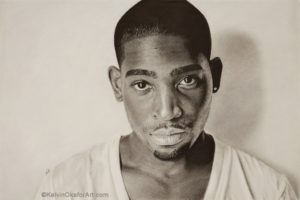 |
| Tinie Tempah |
AD: Why celebrities?
KO: The reason I initially did celebrities was because my work is all freehand…. When I was younger, I used to love the fact that I could draw things and people could recognise what I had drawn just from pencil and paper. So for me celebrities- people like Mother Teresa or Nelson Mandela They have had such influence on us as human beings and have performed such noble deeds and I almost wanted to draw them to glorify them. But at the same time, it was also to show people that I could draw because everyone will recognise a famous face. People like Amy Winehouse are instantly recognisable, so it makes me feel like my drawings are accurate and I can draw with precision.
So it was two things- the fact that I was drawing people who had done noble deeds and on the other hand, people could recognise famous faces. This was a good way for my audience to grow and that is what happened.
After university I started drawing celebrities and straight after university, my friends encouraged me to put some work on Facebook. I joined Facebook and I put my Trafalgar Square Lions there and I started to draw portraits. Then I started to draw celebrities because people engage with the celebrities they recognise. It was also a way for me to practice and see how precisely I could draw.
At the same time, it was to show people that at the end of the day, celebrities are human beings. I think that humanises them. So many people feel like they are a different type of person, when we are all human beings. They probably have a little bit more money in their pockets than we do, but we are all human at the end of the day. These days my subjects are predominantly every day people.
AD: I also read that you like to work predominantly from photos purely because of the amount of time that you spend on each piece. How are you then able to capture the expression that you are looking for? Do you photograph them yourself?
KO: Yes, I photograph them myself. To me photography is inspiration and you can only rely so much on your memory. Even though to be honest, I don’t think that I have actually got a photographic memory, but I do memorise faces and many of my drawings are memory based. Photography is there for me as proof of a moment. You know, once you take a photograph it is there forever, but when you have it in your memory, it may change based on what you felt or how you were feeling at that moment, so it can be exaggerated.
I take many photographs at different angles and also I might take the eyes and lips from different photographs and put them together to make up the final result. And the wonderful thing about it is- and this is the thing with hyper-realism. You have the chance to alter or to move something because- you can draw inspiration from photographs- with lighting for example. When you photograph a subject it might be too dark, but you have the freedom to exaggerate the light from somewhere else to really convey an essence about someone and bring forward the colour of their eyes or their hair. You know…
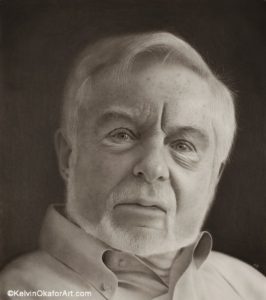 |
| Sir Derek Jacobi |
AD: Do you use photo-shop to chop stuff up and make it how you want it before you start working from it?
KO: No just the ordinary photographs that I work from, but it helps for me to be able to turn it black and white because when you are working in pencils, it can be very difficult to get the values of greens and reds as they are very similar. But when it is in black and white, you won’t know what colour is which. Then I just use how I feel. When I have the photograph there, very literally I can work around the shape and then I have the freedom to change the angle or to bring the light in from somewhere else just by using my imagination.
AD: I have seen your list of exhibitions- which is very impressive considering that you only graduated in 2009! Were any of them solo shows or is this one your first solo show?
KO: Yes, this is my first solo show, which is why I said that this is like a dream. I am ever so grateful… There is just no way that I can express my gratitude because I have always been fed negative comments about struggling artists and only successful once they die. To have this considering where I have come from… It has shown me to really focus during hard times and to go for what you really love and believe in. All of the shows I have had before this one. The Mall Galleries and the National Open art Competition… I am very grateful.
AD: I was at the opening for the National Open art Competition. That was when I first saw your work and I was in complete awe! That was in 2012 wasn’t it?
KO: Wow, thank you! Yeah it was.
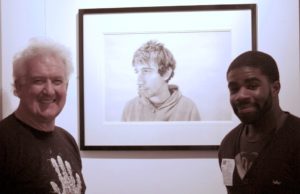 |
| Kelvin Okafor with Neil Lawson-Baker. Founder of National Open Art Competition and his piece for the competition |
AD: Can you remember when you sold your first piece?
KO: The very first piece of work I sold was at my final year show at university at the Truman Gallery. After the show there was some interest in my Trafalgar Square Lions piece. I was not sure how to price it as I was just starting out. I have always been quite humble as an individual. It has never been about money for me, my love for art. But you have to have confidence in your work. The prices of my works are what they are right now because of the value and the demand. But back then, the value was £100 or £200 for a portrait, I didn’t mind and that is about what I sold it for.
AD: What did that first sale feel like?
KO: Amazing. For my family, it made them feel like there may be something. Because unfortunately, there was not really much emotional support for me in terms of pursuing a career in art. They have always wanted me to do what I love to do, but they were looking out for me financially and they did not feel like it would be lucrative for me to have a career in art. They thought it was just me being selfish and I felt selfish just doing what I loved to do and not thinking about money. But after selling that drawing, it made them think that this could work out. It made me feel like that as well. I felt like I could actually profit as an artist.
AD: Your parents, are they Nigerian?
KO: They are Nigerian yes.
AD: My parents are Ghanaian so I can understand where you are coming from! Traditional African parents are often very much of the mindset that you are not going to make any money doing this type of thing so what is the point. They say things like, “Be a lawyer, a doctor, an accountant! What is this art! What kind of nonsense, you are going to starve and then who is going to support us your parents?”
KO: Oh my God! That is exactly how it is! And it is sad,. But at the same time, I don’t really blame them because.. I have two sisters- they are twins, and a younger brother who is only 24 and we were all born here in the UK. They wanted us all to be free financially. It is the academic based careers like being a doctor or lawyer that they feel will provide the best opportunities to make money. But at the end of the day, for I wanted to prove that that is not really the case.
.
AD: What would you say has been your biggest challenge to date as an artist and how did you overcome it?
KO: That is a good question. My biggest challenge has been financial. After university, especially when my friends and age mates were are renting their own places, buying their own properties, forming relationships and going out and having that freedom of having a job. Me not being able to support my family, you know it was hard. After university, I continued working with celebrity portraiture. I’ve always been doing portraits but it was only after university that I had a full portfolio. When I joined Facebook between 2009 and 2010, I had this body of work and it was creating quite a big buzz.
I was on different art websites and my name was growing. But I was only 24 at the time and many people thought it was unreal and impossible because of that. I had won no awards and there was nothing of me anywhere so for them, it must be impossible. Then there was an art website that I was a member of and unfortunately, there was a forum made about my work being fake. I don’t even want you to mention the name of the site because sadly, artists that I respected and admired, went on this forum and insulted me. It turned racial. It was not just about my work. When that was happening, I asked the staff for help every day. It is an American website so we were in different time zones. This meant that at 4am I was receiving private emails from people being racist.
The wonderful thing about being online is that you can make friends and artists have communities. But then I found that these same people who were saying nice things about my art were slandering me. At first it felt like a compliment when people were saying it could not be real because the work looked so much like photographs, but when it turned racial and I started receiving hateful emails, I just could not understand it. Emotionally I was a bit low. They chased me everywhere, including Facebook and they even called my university.
AD: What?
KO: Yes! I had a call from my university asking if I was OK because they were having people calling them and asking if I attended the university. They were going around to different art websites to get me removed and certain art websites did so because they had received so many complaints about my work.
In 2010, because my work was growing in a good way, I started to receive some commissions from clients and then some of those clients who had already requested work said that they were not sure because they had heard that my works were fraudulent! It was a very difficult time for me, but at the same time it was the biggest blessing, because then, at that moment, I decided to make Evolutions – which were videos of my drawings where I would photograph my drawings from start to finish at each stage. This showed people how I actually create a portrait. That lead to something wonderful because I was able to inspire and encourage other artists. After that, some people came back and confessed to being one of those who said my work was fake and that they could now see that the work was real and genuine.
Emotionally that was very difficult for me. Financially, I was trying to make a living out of something which I thought could only be commission based work. Losing potential clients and then having this bad reputation and people thinking my work was fake- it was a bit difficult to bounce back from that. So that was tough, but it completely changed around in 2011 when I started to document all of the stages of every drawing that I did.
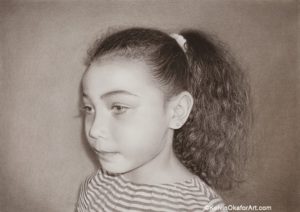 |
| Mia III. Sensitivity |
AD: Wow. That sounds so hard. I had no idea that that happened.
KO: Whenever I have been asked that in an interview, I would never want to name the site.. Because I kind of felt like the staff at that website were not very helpful. I was asking for help for ways to block these people so that I could focus. But they just did not give me any help. They just let it go. I took myself off the site and tried to deal with work again. I don’t want to mention them because by doing so, I will just be giving them more attention- whatever that means.
AD: And then they were calling you racist names on top of it?
KO: Yea! They were saying things like “Nigerian scam artist with your fake drawings…” It was a bit rough. I was seeing those emails and I was shocked. I believe that you attract whatever it is that you think about. So I don’t like to think negative things. I just try to get myself away from it. But when you are receiving those emails you are reminded and then it drops you emotionally. You are trying to focus on the positive and to create new work, but the new work is being slandered by people. But I guess that is the good and the bad of the internet right? You have the plus side where you don’t even have to show your face and you can profit or have a business online. But then at the same time, you can have internet bullies who hide behind a screen and try to make peoples lives a living hell by being negative to people.
AD: Wow. Well moving on to something more positive!
KO: Well I actually think it was a very positive time for me looking back at it. I was very accessible online back then. People would ask me questions and I would always be willing to answer. Even though I am still that way now, but at the same time, I was too accessible to the extent where I was not really focusing on my work. I was trying to answer every single persons need when you can’t really do that. You have to lay back and just focus on your work. I felt like it was a positive time because it made me create videos where people could see my work from start to finish and I found that it helped so many people. For me that is the biggest positive because as an artist, that is my number one objective. As a person even, my objective is to be of service to someone in a good way. So it was a very positive time for me, but at the same time, it was difficult to deal with because I did not understand what was happening.
AD: But you dealt with it in the best way possible, which was to show people what your process was and that obviously reaped positive results in the end.
KO: Yes!
 |
| King Hussein |
AD: Excellent. What has been your biggest success to date and how did you achieve it?
KO: Last year, so much happened, both from a personal perspective and in my life as an artist. It is kind of hard to pin point exactly what the biggest success is. I guess looking from the outside in, being on the BBC, such a big broadcast station, I feel that led to recognition for me. I don’t think that it is because I have this amazing gift and I am something special. No. I think it is because, unfortunately there are so many incredibly talented people who are far greater than I am skilfully but they just have not been recognise by a big station like the BBC. From then, it lead to me meeting high profile people and people that I never thought I would meet. I have drawn some of the people that I am actually meeting now and it is amazing. I feel like that was a great big achievement for me. But like the greatest success… I don’t know… Because I can’t really pin point one thing.. The position that I am in today, I can’t really say that I am established, as yet. For me, being established, is being established world wide. Although I feel like I have had some recognition worldwide, I would love to have my works be seen in galleries worldwide. But as an artist, I do feel like where I am today, being a part of the Albermarle Gallery, having the solo show.. This is my biggest accomplishment.
AD: How did you get involved with the Albermarle Gallery?
KO: Wonderfully, Katherine Roberts my business manager actually knew and recommended the gallery. I have been around the galleries in Mayfair when I was younger and I went in the Albermarle Gallery once but never could I have imagined being a part of the team. We went into the gallery one day. This was after the whole buzz happened. And I came with some of my works to show Tony the gallery manager. His reaction was just amazing. He obviously sees lots of artists and he was just telling me that he had not seen anything like this and that made me feel very very happy.
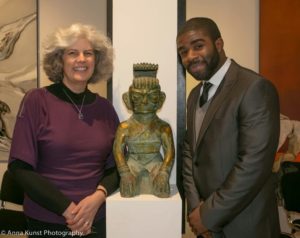 |
| Kathryn Roberts with Kelvin Okafor at Albermarle Gallery Mayfair |
AD: How did you meet Katherine in the first place?
KO: She was the founder of the Cork Street Open art competition and unfortunately, last summer was the last one. But she had the winter show exhibition and I submitted for it, I got in and I had three of my drawings in there. I won the runners up prize and I was in the exhibition. Funnily enough, it was just before the whole BBC thing happened. How it all started- I don’t want to get off subject now, but Middlesex University keep track of the ex students and what they are doing after graduation. The PR lady contacted me for a press release on the phone because they saw that I had been featured in Vanguard newspaper- a big newspaper in Nigeria. They saw the exhibitions that I was in and that I was growing. I gave her the information on the phone and then a few days later, I won the prize at the Cork Street competition. They asked me to do a video interview after winning the prize so we did that. Then she sent it to press outlets everywhere and the BBC caught on. I went back to university to do a master-class and had the interview there. And that is how it kind of took off.
Katherine does business management for artists as well. It was around the end of January 2013 when I was on the BBC. Then after that, my phone just would not stop ringing! It was wild! I started getting hundreds of emails and lots of agents and managers were calling me. I never knew anything about the business side to art so I was a bit confused as to what to do. Thankfully, Katherine was there and she was able to guide me through it.
The prize that I won in Cork Street included a £1000 prize and a part of it was for services- so helping out with promotion and getting you into galleries. She helped me as an agent. So she helped me with emails and getting back to people and I felt comfortable with her. But at the same time, it was so weird, I was being wined and dined by these agents and managers and all these really wealthy people. I am very emotional and am probably too emotional for a guy! I love people and I choose to see the best in them. Having interviews and meetings with these people made me feel extremely uncomfortable, because, looking in their eyes, it felt as though they didn’t see a human being. They saw an asset. They just saw money. I was uncomfortable and I just felt like wow, is this what it is like in the business world. At first with Katherine, I kind of felt the same way, but after getting to know her, I got to trust her as a person. I went along with her and it went from there.
AD: Wow, that must have been scary. I can imagine them with dollar signs in their eyes!
KO: Yea! It was so weird, like I was being invited to the Ritz and all sorts of places. Even going to these places, I was thinking what have I done for you to warrant this- because I didn’t know what they wanted. I just thought they were being really nice and they just wanted get to know me. Not knowing that at the end of a £200 meal that they paid for, they were asking me, “What can we do for you and what can you do for us?” I was thinking- what?? That was a big learning curve. Learning about the whole business side to art and seeing how that works.
AD: Well sort of staying on the subject of business, many Western Art world experts have started to focus their attention to discuss, at some length this shift that is happening towards the African art aesthetic- especially African art from the continent. This shift in art world thinking is obviously having an impact because we had the African Art show at the Tate in 2013, the 1:54 show in 2013 and Lynette Yiadom Boackyi being nominated for the Turner prize in 2013. So there is all this stuff happening! What I am interested in is whether you think that this shift will have any impact on African artists or black artists in general going forward? If so why?
KO: I think it will inspire lots of black artists because it will give them the courage and the faith to embrace their culture and what they want to do. At university, because of my heritage, they thought that I should be making African art and encouraged me to look at artists like Chris Offilli. I felt like that was not necessary because for me, art is expression, it could be absolutely anything. It does not have to be about where you are from. I think that this movement that is happening is good because it will bring more African artists forward to embrace their culture and heritage and I think lots of things can manifest from that. It could be the start of something new.
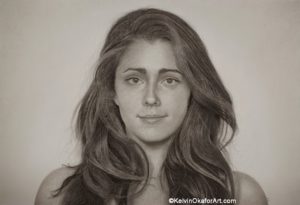 |
| Rochelle |
AD: I think so too. Can you see it impacting your career personally? Despite the fact that you would not look at your work and think that the artist is black, do you see the shift impacting your career because of the fact that you happen to be that?
KO: Maybe emotionally. I can see it encouraging me to embrace my heritage, but in terms of my craft, after this solo show, I intend to work in colour and with pastels in oils. I want to build a portfolio for another solo show, hopefully two years after. It is going to be in portraiture, kind of the same thing I am doing right now but in colour. To be honest, I have always felt like my work may change in terms of genre. I do feel that there is a good chance it could affect me and have an impact on my style of work in the future. I am actually seeing it. In Cork Street, there is a gallery called the Gallery of African Art.
AD: I know the gallery.
KO: I went there recently when there was a Ghanaian artist having his exhibition The work there was amazing and I was inspired… You never really know what could happen. When you are inspired, things change and it could impact you in so many different ways. It could be politics or your work ethic or the way you see art or your philosophy behind art. So I think that there is a chance it could, but I can’t say that it will happen right now because I have this plan for what I want to do right now.
AD: Looking at it from a different perspective, but along similar lines, I have spoken to a number of black artists who are intimidated by the so called Western Art establishment because they are afraid that it will not accept them because they are black. At the end of the day, this is a very old school, traditional institution where they will not necessarily block you for being black- however, there are some artists who have felt that in a very real way. Have you had any experiences which would substantiate that fear and if so what were they and how did you deal with them? Obviously we have discussed what happened with the website who shall not be named! But just in terms of the establishment itself, being as close as you are now, have you felt anything like that?
KO: I feel very fortunate that growing up, my peers were of mixed heritages and cultures. My friends range from Asian, to African, Caribbean, American, European to Irish.. I went to St Ignatius College in Enfield. There were lots of different ethnicities. It was funny because in the school playground, you could see the kids start to segregate. You would have the Irish, the Africans, the blacks, the whites. Everyone separated and stuck with what was familiar to them. But I have always been with everyone and I was accepted everywhere because I embraced everywhere. I didn’t associate myself solely with just one person.
During university, I was one of the only black students. I feel like that may have had a part to play in why my tutors encouraged me to look at African art and to work in that genre. I could appreciate it but that was not what I wanted to do. When applying for the Mall Galleries and the National Open Art competition, some of my friends were asking, why I was making art, as it is a predominantly white upper class interest! “Are you sure they are going to accept you?” They would ask! I would hear these things, but as I said earlier, I am a believer that what we become what we think about and it is very important for us to focus on the good. To focus on what we want. I hear those things but I do not focus on them because I know that if I do, I will attract them.
So when I entered these competitions, I entered feeling proud of what I do and feeling like my work could inspire. It was more about what my work could do for people and it didn’t really have anything to do with race.
But now, I get people asking me if I think this success has come because I am black and because I am from Tottenham… Maybe, maybe not. I don’t want to think like that. I just feel like I got blessed with the opportunity to be recognised for what I do and its been appreciated. People ask me how I can have the confidence to put my work in these upper class shows being from Tottenham and they ask me how I feel about it.
The funny thing as well Adelaide, is that when I think about it, I have had interviews with and I have met people who are from that upper class background. Knowing where I am from and that I am a black male the slang terminology comes in! Some interviewers will actually approach me saying, “You aright bruv?”
AD: No!
KO: Yes! Some of my friends speak like that so I can relate, but when they heard that I could articulate myself without using slang, they completely changed! It was almost like they were shocked that I was intelligent and could speak very well! Maybe I speak very well to them because they assume that I will speak a certain way because of where I am from.
AD: Yes.
KO: It is funny but I just laugh and let it go. I don’t like to think about race in a negative way- even though I see it! It is there! But I don’t like to think about it. I just like to think solely about the work.
AD: Well its not helpful to dwell on it in those terms anyway because as you say, thoughts become things.
KO: I really do believe that
AD: Good. So how would you define success in the art world? Forget everyone else, I want your personal perspective.
KO: I would define success in the art world as being very proud of what you do and you being confident about what you do. Having that faith and courage to share your work with others and have your work in galleries where other people can see it. I think as an artist, that is success, being able to share your work with all types of people. I have always been very sensitive. When I was younger, I used to just draw and I never shared my work. Whenever I was upset, I would draw. When I was happy I would draw. I drew to express myself, to let go and to purge. To be able to share something so personal and for you to be proud of what you do, I feel like that is success you know. Not necessarily financial… Money is a good thing. It can help yourself and others, but I think emotional and spiritual fulfilment is most important. Having that pride and confidence in what you do.
AD: Yes, agreed. By your definition, would you consider yourself to be successful?
KO: Yes I do!
AD: Good!
KO: But I tend to push myself so I am not where I want to be. Even in terms of skill, I still feel like there is still so much more for me to give, but I am very grateful. I still feel that I am successful in terms of the way I view my work.
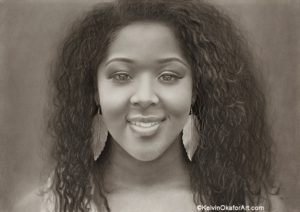 |
| Kerry. Glow |
AD: Brilliant. So what is the biggest and most ambitious dream you have for your work?
KO: The biggest and most ambitious dream… To have it exhibited worldwide. To have my work physically seen in different countries all over the world, not just online. Also to inspire more people around the world. Last September I had a workshop in Tate Modern and it was sold out in an hour. It was incredible! Giving these talks and teaching the younger ones, I feel like it is a dream come true. Even though teaching young ones was not necessarily my ultimate dream, I feel like it is so important because very often, when you are in your early teens and even sometimes into the mid twenties, you don’t really know what you want to do. Believing in your dream can seem so corny and unrealistic. But having someone to encourage your dreams, especially at that age, I think is helpful.
AD: Talking of… What advice would you give to other artists wishing to follow in your footsteps?
KO: Persevere, persevere. If you have something you love to do, do it. It is scary the sacrifices that you have to make to follow your dreams. Friendships, even relationships. Being able to let go is difficult. It was hard for me to let go of a specific relationship. It is also hard for me to sacrifice going out to clubs with friends and having a social life and security- like through having a comfortable nine to five job. But your dream, its not going to be easy to pursue it but… Perseverance is what I would tell any artist. Persevere no matter what.
 |
| Okafor signing limited edition prints |
Kelvin Okafor’s show “Portraits,” is on at the Albernarle Gallery Mayfair until the 31st May 2014
Kelvin Okafor Website
Kelvin Okafor Website
The latest news in contemporary and modern art in New York, London, Paris and Berlin

